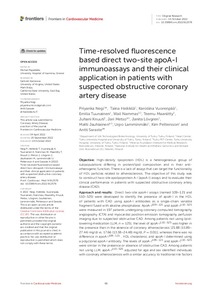Time-resolved fluorescence based direct two-site apoA-I immunoassays and their clinical application in patients with suspected obstructive coronary artery disease
Negi Priyanka; Heikkilä Taina; Vuorenpää Karoliina; Tuunainen Emilia; Nammas Wail; Maaniitty Teemu; Knuuti Juhani; Metso Jari; Lövgren Janita; Jauhiainen Matti; Lamminmäki Urpo; Pettersson Kim; Saraste Antti
https://urn.fi/URN:NBN:fi-fe2022121371177
Tiivistelmä
Objective: High-density lipoprotein (HDL) is a heterogeneous group of subpopulations differing in protein/lipid composition and in their anti-atherogenic function. There is a lack of assays that can target the functionality of HDL particles related to atherosclerosis. The objective of this study was to construct two-site apolipoprotein A-I (apoA-I) assays and to evaluate their clinical performance in patients with suspected obstructive coronary artery disease (CAD).
Approach and results: Direct two-site apoA-I assays (named 109–121 and 110–525) were developed to identify the presence of apoA-I in the HDL of patients with CAD using apoA-I antibodies as a single-chain variable fragment fused with alkaline phosphatase. ApoA-I109−121 and apoA-I110−525 were measured in 197 patients undergoing coronary computed tomography angiography (CTA) and myocardial positron emission tomography perfusion imaging due to suspected obstructive CAD. Among patients not using lipid-lowering medication (LLM, n = 125), the level of apoA-I110−525 was higher in the presence than in the absence of coronary atherosclerosis [21.88 (15.89–27.44) mg/dl vs. 17.66 (13.38–24.48) mg/dl, P = 0.01)], whereas there was no difference in apoA-I109−121, HDL cholesterol, and apoA-I determined using a polyclonal apoA-I antibody. The levels of apoA-I109−121 and apoA-I110−525 were similar in the presence or absence of obstructive CAD. Among patients not using LLM, apoA-I110−525 adjusted for age and sex identified individuals with coronary atherosclerosis with a similar accuracy to traditional risk factors [area under the curve [AUC] (95% CI): 0.75(0.66–0.84) 0.71 (0.62–0.81)]. However, a combination of apoA-I110−525 with risk factors did not improve the accuracy [AUC (95% CI): 0.73 (0.64–0.82)].
Conclusion: Direct two-site apoA-I assays recognizing heterogeneity in reactivity with apoA-I could provide a potential approach to identify individuals at a risk of coronary atherosclerosis. However, their clinical value remains to be studied in larger cohorts.
Kokoelmat
- Rinnakkaistallenteet [27094]
